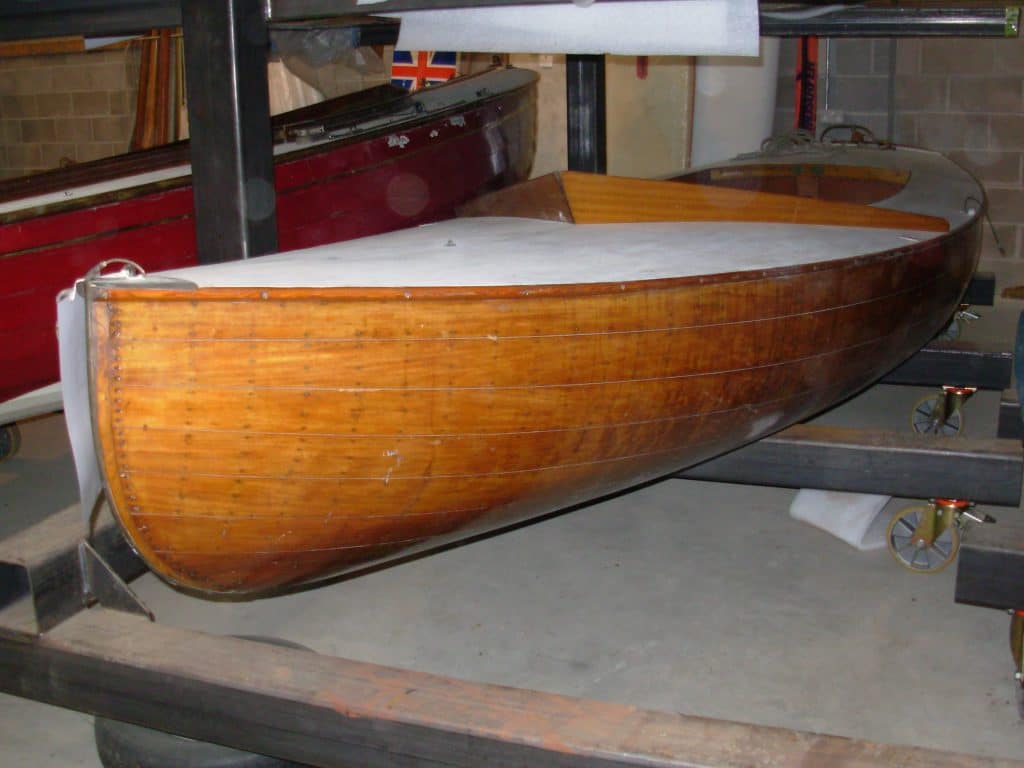
During the late 18th century there were a number of developments aimed at creating a uniform system of measurement and rating to allow boats of similar but slightly different designs to compete on even terms. In 1887 the Yacht Racing Association introduced its LSA (Length Sail Area) rule. Previous rules had focused on hull size but had ignored propulsive power, but this rule brought sail area into the calculation for the first time. It also had the effect of ending the development of extreme designs developed to maximise advantage under the previous rule, but which resulted in boats with very narrow beam and compromised stability.
In 1907 Linton Hope, a naval architect and yachting gold medallist at the 1900 Olympic Games, designed a prototype Half Rater (waterline length of 15 feet and sail area of 200 square feet) which caused quite a stir in Edwardian sailing circles. Black Cap was an 18 foot (length overall) dinghy, built of mahogany planking, copper fastened on spruce frames. As a fast and comfortable boat, it was ideal for inshore and inland sailing. The boat appealed to those of ‘more than average years for whom canoe sailing and snow hiking are becoming rather trying’, as a contemporary issue of Yachting and Boating Monthly magazine put it.
A number of the early Half Raters were sent to colonial India, notably the Malabar Yacht Club, whence 8 boats were sent to Rangoon, Burma, in the early 1920s as the Rangoon Yacht Club was being formed. More boats found their way to Rangoon, totalling 19 by the outbreak of the Second World War. As the invading Japanese armies approached most boats were sunk in lakes in order to keep them out of the hands of the invaders, from where they were mostly recovered and restored after the war, though not all 19 boats have been accounted for.
Black Cap, the prototype remained in the UK. It was raced on the upper Thames by the owner, Mr. H.C. Tower and in 1929 was acquired by Harry Scott-Freeman; oarsman, Olympic hockey gold medal winner, barrister, and the Commodore of Upper Thames Sailing Club based at Bourne End in Buckinghamshire for 40 years. Early in his ownership, Black Cap was converted to Bermudan rig, along with others of the class, with a lengthened mast and shorter boom. Over the years however the boat fell into disrepair.
In 1954 Lt. Col. Peter Waine, who had served in Burma and was deeply involved in developing Half Rater racing in Rangoon, returned to the UK and set about tracing Black Cap. He located it, in disrepair, at the Upper Thames Sailing Club and acquired it to set about a programme of restoration. In order to accomplish this he designed and built his own house and garage around the dimensions of Black Cap’s tall mast. There he spent over 1000 hours on its restoration, finally presenting it to the National Maritime Museum in 1983.
A number of sailing clubs on the upper Thames still race Thames A Raters, a development of the Half Raters, which, with their tall masts and large sail areas, are still amongst the fastest boats regularly raced on this stretch of river.
Dimensions:
Length 5.53m
Beam 1.7m


